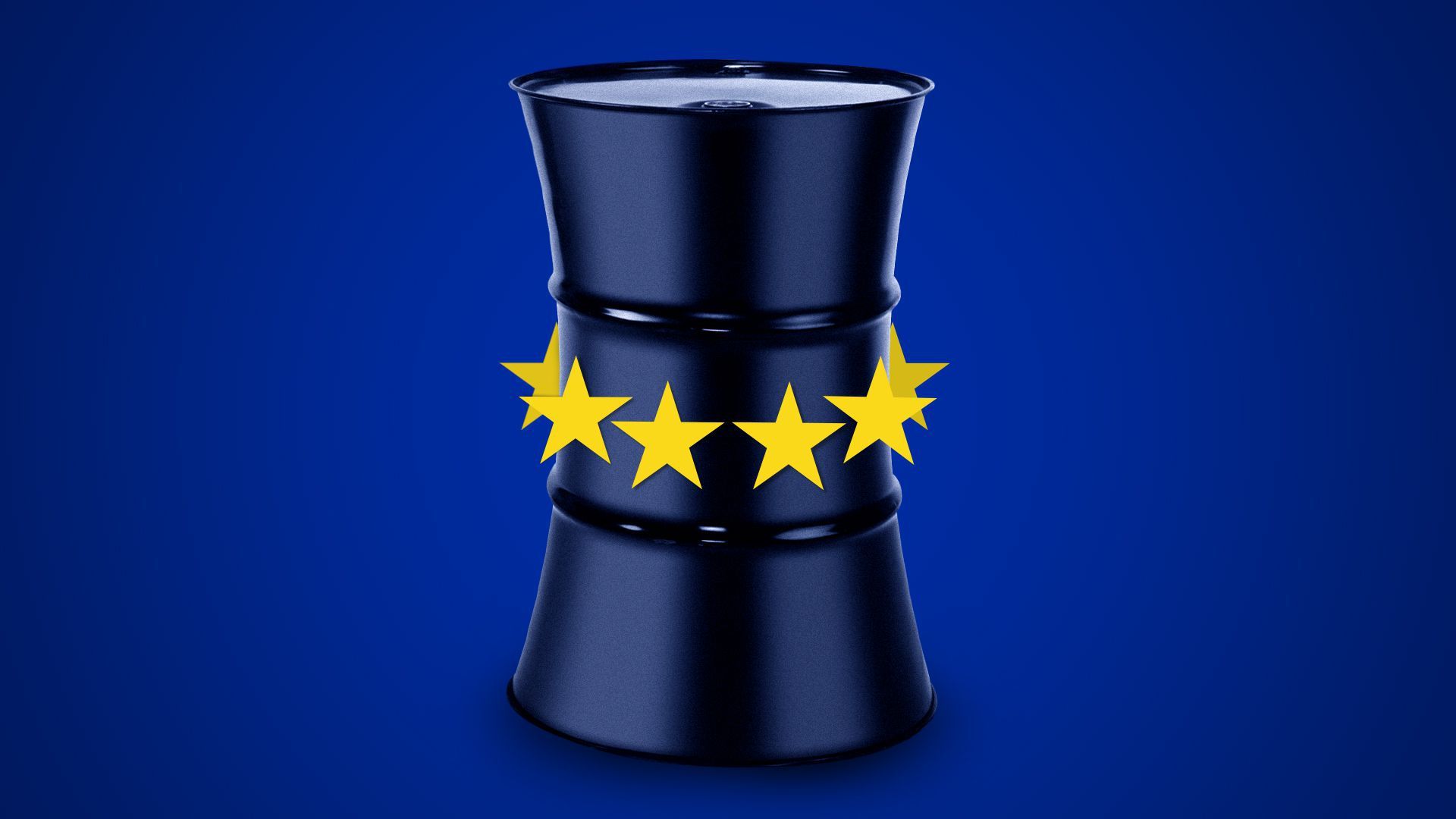| | | | | | | Presented By Paramount | | | | Axios Markets | | By Emily Peck and Matt Phillips · Apr 08, 2022 | | 🌅 🎹 Good day sunshine! Fun fact: On this day in 1943, during wartime, President Franklin Roosevelt issued an executive order freezing wages and prices to get inflation under control. (Go deeper to learn how it worked out.) Today's newsletter is 997 words, 4 minutes. | | | | | | 1 big thing: The unthinkable power play |  | | | Illustration: Shoshana Gordon/Axios | | | | Pressure is mounting for the European Union to do the unthinkable — cut off imports of Russian oil and gas, which have been flowing to the West through all manner of crises for decades, Emily writes. Why it matters: No one quite knows what happens economically if the EU is cut off from its supply. - "It's not something that's been in the models because it was never considered an option," said Antoine Halff, a senior research scholar at the Center on Global Energy Policy at Columbia University.
- While specific predictions are hard to nail down, there is consensus that a full energy embargo would throw the EU into recession and have ramifications geopolitically, as well.
- "Regionally devastating and globally impactful," write the authors of one February paper that lays out options for handling an energy cut-off.
Germany, which is deeply dependent on Russian energy, would likely take it the hardest. - German GDP could decline somewhere between 0.5% and 3%, according to an estimate from a paper published last year by German economists. (The pandemic caused a 4.5% GDP decline in the country).
- Without Russian energy, European companies — from makers of chocolates and candies to chemical manufacturers — could be forced to shutter production, according to a recent NYT report.
- Citizens could also be forced to ration heat and electricity.
The big picture: The EU said yesterday that it would ban imports of coal, and that's fueling chatter about the prospects of a total energy ban. Some countries are pushing for oil to be next, Bloomberg reported. State of play: "Each day, roughly, we are paying €1 billion to import Russian energy, and that's, obviously, a source of income that's used to finance the war," the EU's top diplomat, Josep Borrell, said earlier this week. - It was the first time he'd spoken "candidly" about the issue, noted energy columnist Javier Blas at Bloomberg.
- Cutting off coal and oil, experts said, is relatively doable. Those can be imported from elsewhere. Natural gas, however, requires a level of infrastructure — pipeline, transport and storage — that can't easily be replicated.
Flashback: Germany and the EU were warned for years that their reliance on Russian energy would be a liability, said Anna Mikulska, a nonresident fellow in Energy Studies at Rice University's Baker Institute for Public Policy. - They could have diversified away from Russian energy sources, as some neighboring countries have — Poland and Lithuania both built terminals to import liquified natural gas. Germany has no LNG terminal, and only now is in process of building them.
What's next: Lithuania announced a total ban on Russian energy this week. Other countries may fall in line — eventually. The EU has said it will ween itself off Russian gas "well before 2030." - That sure feels like a long time from now.
Go deeper. |     | | | | | | 2. Catch up quick | | 📉 Russia unexpectedly cut rates, starting a rollback of its emergency measures. (Bloomberg) 🏦 Big U.S. banks are expected to show sharp earnings declines for Q1. (Reuters) 🇨🇦 Canada bans foreigners from buying houses in bid to cool market. (AP) |     | | | | | | 3. Stealth fuel costs |  Data: FactSet; Chart: Jared Whalen/Axios We're all familiar with "pain at the pump," the narrative that launched a thousand local news segments. But there's more than one fuel product that can be pumped, and the extent of the pain can vary, Matt writes. Driving the news: The price surge for industrial fuels such as diesel and jet fuel — byproducts of petroleum refining, known as distillates — have far outstripped the rise in price for consumer-facing products such as gasoline. Why it matters: The surge in these acts as a stealth inflationary force, pushing up prices of a wide range of goods — anything that's trucked in — and services, such as air travel. State of play: The difference in prices among these fuels crisply illustrates the economic concept of "elasticity," or how sensitive demand is to changing prices. - Gasoline demand is much more elastic than distillate demand. That's because consumers can, in many instances, decide to drive less, if gasoline prices get too high.
- Industrial fuel like diesel, however, is less sensitive to climbing costs, because those costs can often be passed along to an end customer elsewhere.
|     | | | | | | A message from Paramount | | How Paramount is reaching new heights | | |  | | | | Introducing the new Paramount. What's in it for you: We offer the top entertainment shows on TV, three recent #1 films at the box office, and Paramount+ — the streaming service which was recently named the fastest-growing brand in any industry. See the latest. | | | | | | 4. 💳 Credit card revival |  Data: FactSet, Federal Reserve; Chart: Axios Visuals Americans racked up the most monthly consumer debt in over a decade in February, amid a surge of credit card swiping, Matt writes. Why it matters: It could mean climbing inflation and falling savings rates are forcing more people to use plastic. Driving the news: The Federal Reserve's monthly consumer credit report for February, out yesterday, showed levels of consumer debt — not including mortgage debt — jumped by $41.8 billion, or 11.3%. - Revolving credit — typically credit cards — rose by a seasonally adjusted annual rate of 21%, up from 4% the prior month.
- Nonrevolving credit, which includes auto and student loans, was up 8.4%.
The bottom line: COVID-era stimulus payments to American families are a distant memory, as is the savings cushion they briefly created. And this data came before the worst of the gasoline price spike. |     | | |  | | | | If you like this newsletter, your friends may, too! Refer your friends and get free Axios swag when they sign up. | | | | | | | | 5. 🧊 Cooling signs |  Chart: Freddie Mac; Axios Visuals The real estate frenzy might be edging down ever so slightly, as mortgage rates rise. The 30-year-fixed rate climbed to 4.72% this week, according to Freddie Mac's data. Why it matters: That's the highest rate since December 2018, and the fastest three-month increase since 1994, Redfin said. (One daily measure has rates hovering even closer to 5%.) Driving the news: The latest evidence of a possible slowdown comes from Redfin, which reported that 12% of home sellers dropped the price on their listings for the four weeks that ended Sunday. Last year at this time, about 9% of homeowners lowered prices. - "A growing share of home-sellers are dropping their prices, buyers are taking less home tours now than they were this time last year, and mortgage purchase applications are declining," Redfin economist Daryl Fairweather told Axios.
Yes, but: The cooling off is most apparent in expensive coastal cities, she said. Buyers in those pricier markets will see less competition for homes; other regions remain hot. |     | | | | | | A message from Paramount | | How Paramount is reaching new heights | | |  | | | | Introducing the new Paramount. What's in it for you: We offer the top entertainment shows on TV, three recent #1 films at the box office, and Paramount+ — the streaming service which was recently named the fastest-growing brand in any industry. See the latest. | | |  | It's called Smart Brevity®. Over 200 orgs use it — in a tool called Axios HQ — to drive productivity with clearer workplace communications. | | | | | | Axios thanks our partners for supporting our newsletters. If you're interested in advertising, learn more here.
Sponsorship has no influence on editorial content. Axios, 3100 Clarendon Blvd, Suite 1300, Arlington VA 22201 | | | You received this email because you signed up for newsletters from Axios.
Change your preferences or unsubscribe here. | | | Was this email forwarded to you?
Sign up now to get Axios in your inbox. | | | | Follow Axios on social media:    | | | | | |











No comments:
Post a Comment